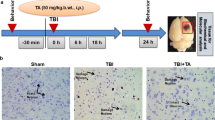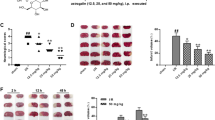Abstract
A major component of green tea, a widely consumed beverage, is (−)-epigallocatechin gallate (EGCG), which has strong antioxidant properties. Our previous study has indicated that free radical production following rat traumatic brain injury (TBI) induces neural degeneration. In this study, we investigated the effects of EGCG on cerebral function and morphology following TBI. Six-week-old male Wistar rats that had access to normal drinking water, or water containing 0.1% (w/v) EGCG ad libitum, received TBI with a pneumatic controlled injury device at 10 weeks of age. Immunohistochemistry and lipid peroxidation studies revealed that at 1, 3 and 7 days post-TBI, the number of 8-hydroxy-2′-deoxyguanosine-, 4-hydroxy-2-nonenal- and single-stranded DNA (ssDNA)-positive cells, and the levels of malondialdehyde (MDA) around the damaged area after TBI, significantly decreased in the EGCG treatment group compared with the water group (P < 0.05). Most ssDNA-positive cells in the water group co-localized with neuronal cells. However, in the EGCG treatment group, few ssDNA-positive cells co-localized with neurons. In addition, there was a significant increase in the number of surviving neuronal cells and an improvement in cerebral dysfunction after TBI in the EGCG treatment group compared with the water group (P < 0.05). These results indicate that consumption of water containing EGCG pre- and post-TBI inhibits free radical–induced neuronal degeneration and apoptotic cell death around the damaged area, resulting in the improvement of cerebral function following TBI. In summary, consumption of green tea may be an effective therapy for TBI patients.








Similar content being viewed by others
References
Ates, O., Cayli, S., Altinoz, E., Gurses, I., Yucel, N., Sener, M., et al. (2007). Neuroprotection by resveratrol against traumatic brain injury in rats. Molecular and Cellular Biochemistry, 294, 137–144.
Buffo, A., Rolando, C., & Ceruti, S. (2010). Astrocytes in the damaged brain: Molecular and cellular insights into their reactive response and healing potential. Biochemical Pharmacology, 79, 77–89.
Chan, P. H., Fishman, R. A., Longar, S., Chen, S., & Yu, A. (1985). Cellular and molecular effects of polyunsaturated fatty acids in brain ischemia and injury. Progress in Brain Research, 63, 227–235.
Chirumamilla, S., Sun, D., Bullock, M. R., & Colello, R. J. (2002). Traumatic brain injury induced cell proliferation in the adult mammalian central nervous system. Journal of Neurotrauma, 19, 693–703.
Gage, F. H. (2000). Mammalian neural stem cells. Science, 287, 1433–1438.
Hall, E. D., & Braughler, J. M. (1989). Central nervous system trauma and stroke. II. Physiological and pharmacological evidence for involvement of oxygen radicals and lipid peroxidation. Free Radical Biology and Medicine, 6, 303–313.
Hong, J. T., Ryu, S. R., Kim, H. J., Lee, J. K., Lee, S. H., Kim, D. B., et al. (2000). Neuroprotective effect of green tea extract in experimental ischemia-reperfusion brain injury. Brain Research Bulletin, 53, 743–749.
Itoh, T., Imano, M., Nishida, S., Tsubaki, M., Hashimoto, S., Ito, A., et al. (2011). Exercise inhibits neuronal apoptosis and improves cerebral function following rat traumatic brain injury. Journal of Neural Transm, 118, 1263–1272.
Itoh, T., Satou, T., Hashimoto, S., & Ito, H. (2005). Isolation of neural stem cells from damaged rat cerebral cortex after TBI. Neuroreport, 16, 1687–1691.
Itoh, T., Satou, T., Hashimoto, S., & Ito, H. (2007). Immature and mature neurons coexist among glial scars after rat traumatic brain injury. Neurological Research, 29, 734–742.
Itoh, T., Satou, T., Nishida, S., Tsubaki, M., Hashimoto, S., & Ito, H. (2009a). Improvement of cerebral function by anti-amyloid precursor protein antibody infusion after traumatic brain injury in rats. Molecular and Cellular Biochemistry, 324, 191–199.
Itoh, T., Satou, T., Nishida, S., Tsubaki, M., Hashimoto, S., & Ito, H. (2009b). The novel free radical scavenger, edaravone, increases neural stem cell number around the area of damage following rat traumatic brain injury. Neurotoxicity Research, 16, 378–389.
Itoh, T., Satou, T., Nishida, S., Tsubaki, M., Imano, M., Hashimoto, S., et al. (2010). Edaravone protects against apoptotic neuronal cell death and improves cerebral function after traumatic brain injury in rats. Neurochemical Research, 35, 348–355.
Jang, S., Jeong, H. S., Park, J. S., Kim, Y. S., **, C. Y., Seol, M. B., et al. (2010). Neuroprotective effects of (−)-epigallocatechin-3-gallate against quinolinic acid-induced excitotoxicity via PI3K pathway and NO inhibition. Brain Research, 1313, 25–33.
Kawamata, T., Katayama, Y., Hovda, D. A., Yoshino, A., & Becker, D. P. (1995). Lactate accumulation following concussive brain injury: The role of ionic fluxes induced by excitatory amino acids. Brain Research, 674, 196–204.
Kontos, H. A. (1985). George E. Brown memorial lecture. Oxygen radicals in cerebral vascular injury. Circulation Research, 57, 508–516.
Lee, H., Bae, J. H., & Lee, S. R. (2004). Protective effect of green tea polyphenol EGCG against neuronal damage and brain edema after unilateral cerebral ischemia in gerbils. Journal of Neuroscience Research, 77, 892–900.
Lee, S. Y., Kim, C. Y., Lee, J. J., Jung, J. G., & Lee, S. R. (2003). Effects of delayed administration of (−)-epigallocatechin gallate, a green tea polyphenol on the changes in polyamine levels and neuronal damage after transient forebrain ischemia in gerbils. Brain Research Bulletin, 61, 399–406.
Lee, E. J., Lee, M. Y., Chen, H. Y., Hsu, Y. S., Wu, T. S., Chen, S. T., et al. (2005). Melatonin attenuates gray and white matter damage in a mouse model of transient focal cerebral ischemia. Journal of Pineal Research, 38, 42–52.
Loren, D. J., Seeram, N. P., Schulman, R. N., & Holtzman, D. M. (2005). Maternal dietary supplementation with pomegranate juice is neuroprotective in an animal model of neonatal hypoxic-ischemic brain injury. Pediatric Research, 57, 858–864.
McGraw, J., Hiebert, G. W., & Steeves, J. D. (2001). Modulating astrogliosis after neurotrauma. Journal of Neuroscience Research, 63, 109–115.
Park, J. W., Jang, Y. H., Kim, J. M., Lee, H., Park, W. K., Lim, M. B., et al. (2009). Green tea polyphenol (−)-epigallocatechin gallate reduces neuronal cell damage and up-regulation of MMP-9 activity in hippocampal CA1 and CA2 areas following transient global cerebral ischemia. Journal of Neuroscience Research, 87, 567–575.
Rice, A. C., Khaldi, A., Harvey, H. B., Salman, N. J., White, F., Fillmore, H., et al. (2003). Proliferation and neuronal differentiation of mitotically active cells following traumatic brain injury. Experimental Neurology, 183, 406–417.
Sakurai, M., Nagata, T., Abe, K., Horinouchi, T., Itoyama, Y., & Tabayashi, K. (2003). Oxidative damage and reduction of redox factor-1 expression after transient spinal cord ischemia in rabbits. Journal of Vascular Surgery, 37, 446–452.
Sugawara, T., Noshita, N., Lewen, A., Gasche, Y., Ferrand-Drake, M., Fujimura, M., et al. (2002). Overexpression of copper/zinc superoxide dismutase in transgenic rats protects vulnerable neurons against ischemic damage by blocking the mitochondrial pathway of caspase activation. Journal of Neuroscience, 22, 209–217.
Wang, X., Karlsson, J. O., Zhu, C., Bahr, B. A., Hagberg, H., & Blomgren, K. (2001). Caspase-3 activation after neonatal rat cerebral hypoxia-ischemia. Biology of the Neonate, 79, 172–179.
Weinreb, O., Amit, T., Mandel, S., & Youdim, M. B. (2009). Neuroprotective molecular mechanisms of (−)-epigallocatechin-3-gallate: A reflective outcome of its antioxidant, iron chelating and neuritogenic properties. Genes & Nutrition, 4, 283–296.
Weissman, L., de Souza-Pinto, N. C., Stevnsner, T., & Bohr, V. A. (2007). DNA repair, mitochondria, and neurodegeneration. Neuroscience, 145, 1318–1329.
Won, M. H., Kang, T., Park, S., Jeon, G., Kim, Y., Seo, J. H., et al. (2001). The alterations of N-Methyl-d-aspartate receptor expressions and oxidative DNA damage in the CA1 area at the early time after ischemia-reperfusion insult. Neuroscience Letters, 301, 139–142.
**ong, Y., Gu, Q., Peterson, P. L., Muizelaar, J. P., & Lee, C. P. (1997). Mitochondrial dysfunction and calcium perturbation induced by traumatic brain injury. Journal of Neurotrauma, 14, 23–34.
**ong, Y., Mahmood, A., Lu, D., Qu, C., Kazmi, H., Goussev, A., et al. (2008). Histological and functional outcomes after traumatic brain injury in mice null for the erythropoietin receptor in the central nervous system. Brain Research, 1230, 247–257.
Yu, J., Jia, Y., Guo, Y., Chang, G., Duan, W., Sun, M., et al. (2010). Epigallocatechin-3-gallate protects motor neurons and regulates glutamate level. FEBS Letter, 584, 2921–2925.
Acknowledgments
This work was supported by the Grant-in-Aid for Scientific Research (21500803). The authors thank Mari Yachi for technical assistance.
Conflict of interest
The authors declare they have no conflict of interest.
Author information
Authors and Affiliations
Corresponding author
Rights and permissions
About this article
Cite this article
Itoh, T., Imano, M., Nishida, S. et al. (−)-Epigallocatechin-3-gallate Protects Against Neuronal Cell Death and Improves Cerebral Function After Traumatic Brain Injury in Rats. Neuromol Med 13, 300–309 (2011). https://doi.org/10.1007/s12017-011-8162-x
Received:
Accepted:
Published:
Issue Date:
DOI: https://doi.org/10.1007/s12017-011-8162-x




